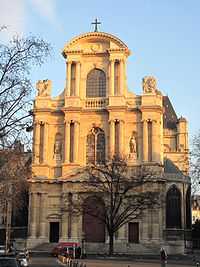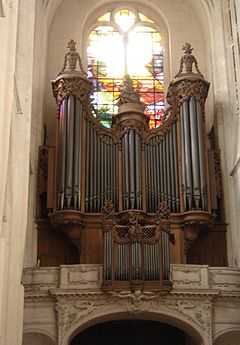St-Gervais-et-St-Protais


St-Gervais-et-St-Protais Church of Paris is located in the 4th arrondissement of Paris, on Place Saint-Gervais in the Marais district, east of City Hall (Hôtel de Ville).
Beginning in 1653, the church employed and sheltered the Couperin family, one of the most famous dynasties of French musicians, for more than two centuries. On one side of the church, the home of the famous harpsichordists, organists, and composers still stands, with a plaque commemorating the Couperins' tenure in this place. The organ used by Louis and François Couperin still exists today inside the church. Built by the most famous organ builders of the time — François-Henri Clicquot, Louis-Alexandre Clicquot, and Robert Clicquot — it is a fine example of the French baroque style.
History
This church is one of the oldest in Paris. Its existence at this place is mentioned as early as the fourth century. Dedicated to Gervasius and Protasius, the church was formerly the seat of the powerful brotherhood of wine merchants. It assumed its present appearance in the 16th century. Its façade was completed much later, however, about 1620.
The present church was begun in the Gothic style in 1494, the chapels of the apse were finished in 1530 and the transept in 1578.[1] The doorway of the church was built in 1616–1620 by Claude Monnard in the classical style. Between 1600 and 1628, a second row of chapels was built on the north side including the golden chapel ornamented with painted woodwork.[2]
The facade presents an exceptional feature, with columns of the 3 orders : Doric at the ground floor, Ionic at the second floor, Corinthian at the third floor.
The church was refurbished to coincide with Pope John Paul II's second visit to Paris with the continued installation of a number of new stained glass windows (Claude Courageux, earlier work by Sylvie Gaudin. The five windows by Gaudin are worth the trip to Paris by themselves. Had she survived a battle with cancer in 1994 (age 44), she would likely have done more work in this church. Search out her work in Eglise St-Joseph in Pontivy, unbelievable. Keys available at the Mayor's offices second floor, about a block away, closed noon till 2:00pm weekdays.
The crossroads of the elm
The square, Place Saint-Gervais, located at the foot of the steps outside the church, was, for a long time, called the Crossroads of the Elm. Since the Middle Ages, a venerable monarch of an elm, grew at its center. The inhabitants of the neighborhood would exchange money there. Several ancient pictures of this elm still remain, in the stalls of the church, and on some nearby buildings.
Medieval houses
One side of the church is skirted by the Rue François Miron, where two of the oldest medieval houses of Paris survive, at numbers 11 and 13. They date, most likely, from the 14th century. One can see the exposed wood of the half-timbered structures.
A wartime tragedy

On 29 March 1918, a German shell, fired by the long-range "Paris Gun", fell on the church, killing 88 people and wounding 68 others; the explosion collapsed the roof when a Good Friday service was in progress. This was the worst single incident involving a loss of civilian lives during the German bombardment of Paris in 1918. Among those killed was Rose-Marie Ormond Andre-Michel, the niece and a favorite model of John Singer Sargent.[3]
Monastic Fraternities of Jerusalem
Since 1975 this church is the headquarters of the Monastic Fraternities of Jerusalem founded by Père Pierre-Marie Delfieu with the authorisation of the then Archbishop of Paris, François Marty. Devoted to monastic life in an urban context, most of its members work part-time in civil occupations. Highly conscious of oecumenical preoccupations (Judaism which enjoys a high profile in the immediate neighbourhood, Orthodoxy, Protestantism),St. Gervais is renowned for its distinctive liturgy, which has adopted Lutheran hymn music and Orthodox troparia. St. Gervais has founded a number of communities in France (e.g. Mont St. Michel, Vezelay, Magdala - Sologne and elsewhere (e.g. Florence, Brussels, Cologne, Warsaw, Montreal).
Metropolitain
The St-Gervais-et-St-Protais Church is:
| Located near the Métro stations: Hôtel de Ville and Pont Marie. |
![]()
![]()
![]() It is served by lines 1, 7, and 11.
It is served by lines 1, 7, and 11.
See also
Pierre et Luce
References
| Wikimedia Commons has media related to Église Saint-Gervais-Saint-Protais. |
- ↑ Huisman, G. & Poisson, G. (1966) Les monuments de Paris. Paris: Hachette; pp. 98–99
- ↑ Huisman, G. & Poisson, G. (1966); pp. 169–70
- ↑ "Rose-Marie Ormond Andre-Michel". Retrieved 18 November 2013.